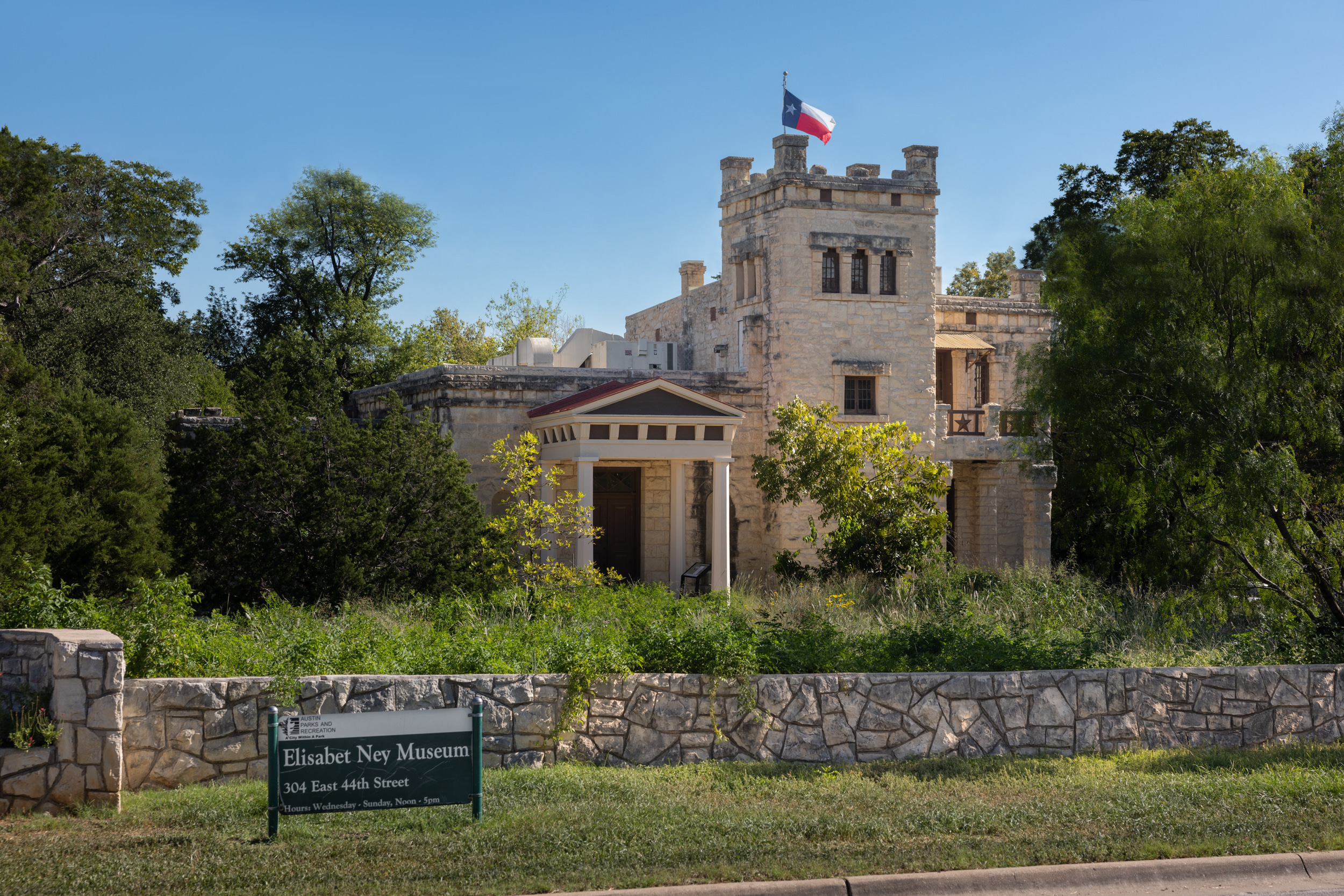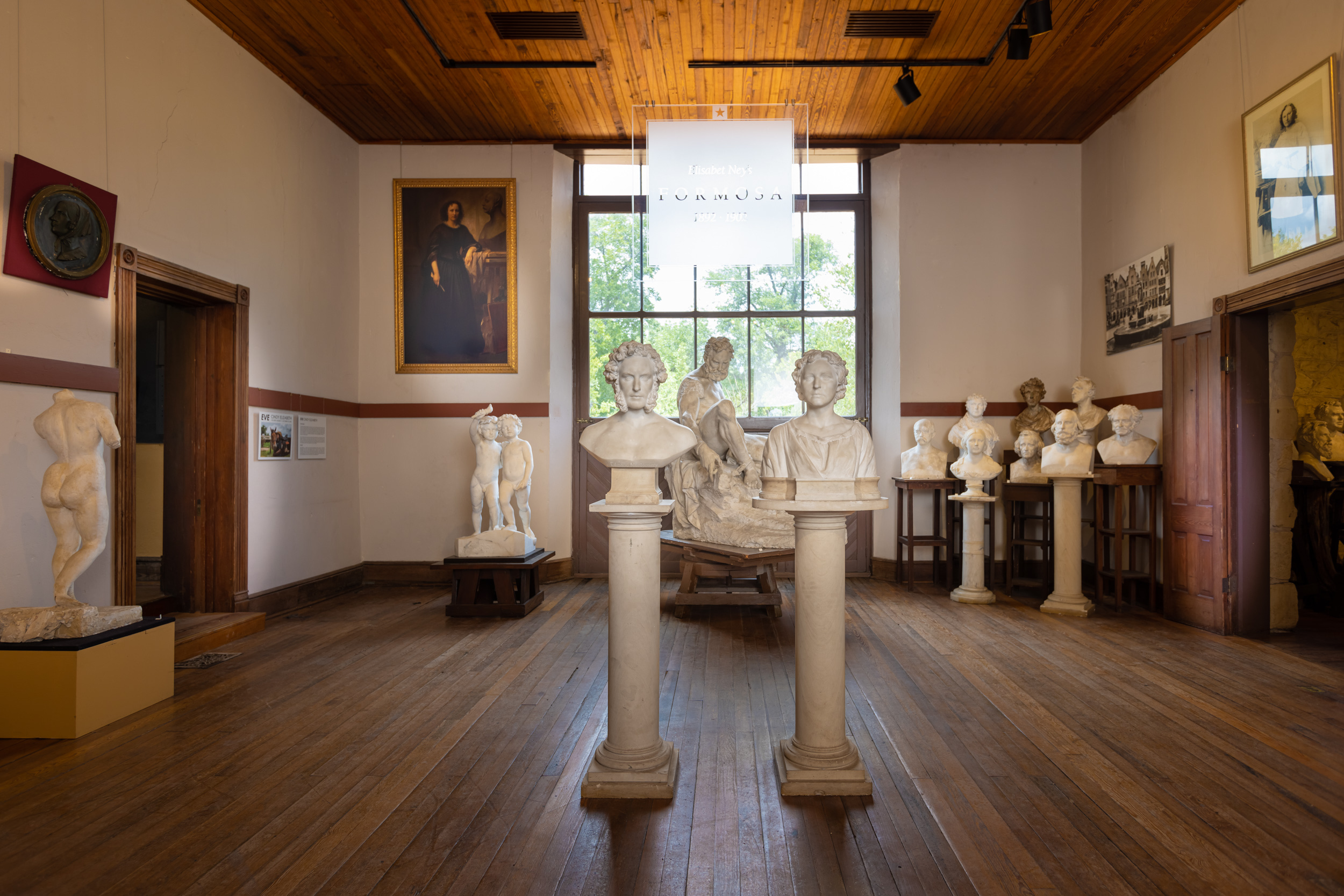
The castle-like Elisabet Ney Museum can be found in the Hyde Park neighborhood of Austin. Photo courtesy Elisabet Ney Museum
At the corner of East 44th Street and Avenue H in the Hyde Park neighborhood of Austin stands a three-story stone structure that looks like a small medieval castle, with a keep (or fortified tower) and a colonnaded portico at the entrance. If you lived in Austin in the late 1800s, you might have caught a glimpse of the building’s original owner, the famed sculptor Elisabet Ney, lounging on a cot on the flat second-floor roof. She loved to sleep beneath the stars.
Born in 1833 in Prussia—what is now Germany—Ney was a trailblazing female artist who created statues and busts of some of Europe’s most well-known leaders and philosophers of the period, including Otto von Bismarck, Arthur Schopenhauer, Giuseppe Garibaldi, and perhaps most famously, King Ludwig II of Bavaria, also known as “the Mad King.” She moved to Texas in the late 19th century in her older age, first to Waller County and eventually to Austin, where she hoped to bring culture to the state by way of its political center.
You can still see Ney’s best-known works as they are housed in the home studio where she once lay under the stars. Now a museum, the home is a cornerstone of the Hyde Park National Register Historic Neighborhood, just north of The University of Texas at Austin. Its neoclassical style stands out among the redeveloped properties that have cropped up around this historic area.
Today, many people who pass by the 2.5-acre historic property think it’s an old, abandoned building, especially because of the overgrown prairie grasses surrounding the home. Museum curators say that is intentional: Ney was a naturalist and would have wanted her property to remain the same as it was back then: wild and unmanicured.
Inside the museum, which is free and open to the public Wednesdays through Sundays, visitors can find sculptures from Ney’s nearly 50-year career, including some of her most famous pieces of notable European figures and Texas patriots and generals. Since Ney worked on commissions, the marble versions of her sculptures went to her patrons. She kept the plaster of paris molds, which are the majority of the dozens of pieces on display.
Museum volunteer Sree Bhasin explains that while most museums are focused on artifacts and exhibits, she considers Elisabet Ney’s a “living” one.
“I feel Ney is very much here,” Bhasin says. “It is really Ney as much as her collection.”
Raised in a Catholic family, Ney always wanted to be an artist. As a young girl, she went on a hunger strike when her parents refused to let her study sculpting in Berlin. They eventually came to a compromise: She’d go to the looks like it’s the Academy of Fine Arts in Munich instead, where they had family ties, accompanied by a chaperone. Ney was the first female sculptor to be admitted to the academy. As a woman, she wasn’t allowed to attend live nude sculpting courses so she had to draw animals or look to Greek sculptors to learn anatomy. Ney graduated at the top of her class and did eventually study in Berlin under master sculptor Christian Daniel Rauch, who became her mentor.
In 1873, Ney moved to Texas with her husband, physician and philosopher Edmund Montgomery, and their two sons, Arthur and Lorne. They settled first at Liendo Plantation in Waller County near Hempstead. Ney took a break from art and soon after lost her son Arthur, who died shortly before his second birthday of diphtheria. The family moved to Austin in 1882, where Ney resumed sculpting in her home studio, which she named Formosa.
Ney lived a very opulent life in Germany, so to move to Texas in the 1880s when it was only vast country was a huge change, Bhasin says. At Formosa, she frequently held salons, where artists and philosophers would come to talk about politics and social issues. A nonconformist, Ney wore her hair short and never took her husband’s name—nor admitted to marrying him—because she didn’t want to belong to anyone like property.
“She broke all ceilings, not just glass ceilings,” Bhasin says. “From marriage to work to being so outspoken, people say she was ahead of her time. I think she would be ahead of her time even now.”

A portrait of the artist (back wall) presides over busts and statues that Elisabet Ney sculpted throughout her nearly 50-year career. Photo courtesy Elisabet Ney Museum
In 1892, Ney was commissioned to capture the likenesses of Sam Houston and Stephen F. Austin, heroes of the Texas Revolution, for the World’s Fair in Chicago. Both sculptures now reside in the South Foyer of the Texas State Capitol, along with marble versions in the U.S. Capitol’s National Statuary Hall. Her last piece, Lady MacBeth, a marble sculpture created when she was in her 70s that is believed to be a self-portrait, is housed at the Smithsonian. The plaster cast of the piece, which towers more than 6 feet tall, is in the Elizabet Ney Museum.
Ney died in 1907 in her studio from a heart attack. She was 74. She and Montgomery, who died four years later, were buried at Liendo Plantation.
“I feel like there’s something really unique about being able to look at the history of such a strong female artist and all the things that have come out of the Ney being here,” museum curator Jade Walker says. “This was the first art museum in Central Texas and the first in Austin, and it lays the flavor of the Austin creative scene. Because Ney was such an outlier in so many ways and such an iconoclast, I think that speaks to the way that our community sees themselves, as outliers.”
Walker added that you don’t have to be a tourist to enjoy the Elisabet Ney Museum. Many of the people who roam in day after day tell the volunteers that they used to live in the neighborhood or have passed by on drives and never made a point to stop in. “It’s a hidden gem,” Walker said.
The museum also hosts events, including its annual Ney Day on May 19—with artist-led projects, demonstrations, games, music, and food—and salons featuring local artists that are reminiscent of the ones Ney used to have. In recent years, the museum has also begun showing the work of more contemporary artists, particularly women and nonbinary artists. “That story is so important as we evolve as a museum,” Walker says.
More information about the museum and these events can be found on the city of Austin’s website.








